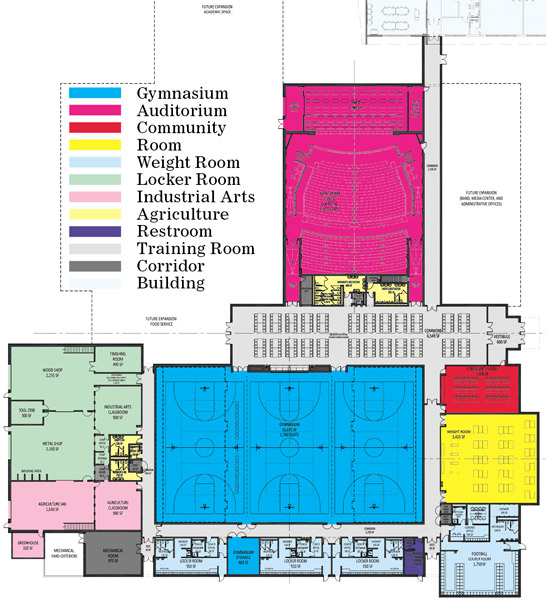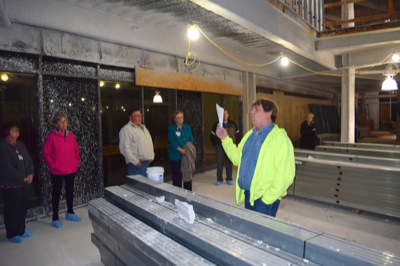Thursday, November 30th, 2017
Marion Local unveils plans for new facility
Gyms, auditorium included
By Sydney Albert

Submitted Photo
A sketch of the proposed Marion Local Schools facilities project. The light-blue box on the upper margin shows the location of the current K-8 building.
MARIA STEIN - Plans for the proposed new Marion Local Schools facility, featuring three gymnasiums, an auditorium and an industrial/ag education suite, were revealed during a community meeting on Wednesday night.
Superintendent Mike Pohlman said school board members in the past had approached needs on a piecemeal basis, but now board members want to address improvements as a whole. The No. 1 comment he's heard from the community regarding the possible expansion is that if board members are going to seek improvements, they should do it right the first time.
The main entrance to the new building would open into a common space of about 6,500 square feet and would be capable of serving 300 students as a possible future dining facility. Restrooms and a concession stand would be placed between the common area and the 7,500-square-foot auditorium, which would be able to seat 600 people and would have a second-floor control booth.
Attached to a vestibule at the entrance would be a 1,500-square-foot community room that could fit up to 100 people. It could be made accessible to groups looking for meeting space without giving visitors access to the rest of the school building, Pohlman said.
The new 17,000-square-foot gymnasium would hold three courts, with curtains that could separate the different courts and bleachers that would allow seating for 1,800 people. A 3,500-square foot weight room also would be included in the building. Pohlman said it would be slightly larger, more secure and better climate-controlled than the current weight room.
A football locker room with restrooms, showers, a coaches' office and a small conference room would make up the southeast corner of the building. The plan also features three smaller locker rooms along the southern edge of the building, each with coaches' offices, showers and restrooms.
The industrial and agricultural education suite would be on the far west side of the building. It would include a wood shop, a finishing room, a metal shop, an agricultural lab space, a mechanical room and a small greenhouse as well as two classrooms. Teachers would be able to keep an eye on students both from the classrooms and the shop or lab spaces through glass windows.
In addition, between 38,000 and 45,000 square feet is also set aside in the plans for future growth, such as adding more classrooms. Due to debt limitations, adding the classrooms is not a current possibility, Pohlman noted.
Asked how the district's student population compared with that of decades ago, Pohlman acknowledged that enrollment had decreased. The expansion wasn't so much about accommodating more students as it was meeting needs for floor space. The current agricultural and industrial classes need more room than they have, and he said more groups have come to the school asking to use gym space.
Several audience members said the building or at least some aspects of it such as the auditorium seemed to be luxury items that don't fill educational needs, aside from the industrial and ag education space.
Pohlman said board members had addressed much of the district's educational needs in the 1990s, and while much of the building is dedicated for extracurricular activities, school involvement helps foster a sense of belonging and pride that students might not have otherwise. He said while district officials are not trying to "keep up with the Joneses," they still wanted to give their students more of what students in other districts already get.
Additionally, the auditorium, which was estimated by architects Garmann-Miller to be about 20-25 percent of the project, would be used by students from grades K-12 and could also be rented to outside groups, Pohlman said.
Questioned about the lifespan of the old high school, Matt Guggenbiller of Garmann-Miller said the facility had gone through a 27-point examination following Ohio Facilities Construction Commission guidelines. The old high school would need to have the roof replaced, and the heating and cooling systems, which are reaching the end of their lives, also would need to be replaced.
Other upgrades such as upgrading the lighting to LED lights and installing a new generator would be needed, as the current generator operates only the building's fire pump. A complete upgrade at the high school would cost $4.3 million, Guggenbiller said.
The cost to operate the new facility is estimated at $150,000 annually, according to a FAQ sheet handed out by the school at the meeting. The cost of completing all master plan projects and upgrades to existing buildings would be between $16.11 million and $25.38 million, according to Garmann-Miller data released at an earlier meeting, though Pohlman said those preliminary numbers were from 2015 and may not reflect the actual cost of the project.
No action was taken at Wednesday's meeting, and district officials were unsure of when the project would be presented on a ballot for public vote.




